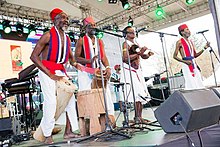Mijikenda
Les Mijikenda (littéralement « les neuf villes ») sont les neuf tribus établies le long des côtes du Kenya, de la Somalie et de la Tanzanie. Elles comprennent les Digo, Chonyi, Kambe, Duruma, Kauma, Ribe, Rabai, Jibana et Giriama. Chacune a des coutumes et une langue propre, même si les langues sont similaires entre elles et avec le swahili. Les traditions sont riches et préservées car les colonisateurs britanniques et allemands ont eu une grande influence sur l'intérieur du Kenya, mais ont laissé à l'écart la côte plus pauvre.
Ethnonymie
modifierSelon les sources et le contexte, on observe plusieurs variantes : Kinyika, Makayachenda, Midzichenda, Miji Kenda, Mijikendas, Nika, Nyanika, Nyika, Nyka, Wanika, Wanyika, Wanyka[2].
Histoire
modifierHabitat traditionnel
modifierEn 1971 le gouvernement kényan a établi un village touristique, Bomas of Kenya, près de Nairobi, afin de préserver, maintenir et promouvoir les valeurs culturelles des différentes populations. Des huttes traditionnelles mijikenda y ont ainsi été reconstituées[3].
Notes et références
modifier- « 2019 Kenya Population and Housing Census Volume IV: Distribution of Population by Socio-Economic Characteristics », sur Kenya National Bureau of Statistics (consulté le )
- Source RAMEAU, BnF [1]
- « Les maisons traditionnelles du Kenya », maison-monde.com [2]
Voir aussi
modifierBibliographie
modifier- (en) Thomas J. Herlehy, An economic history of the Kenya coast : the Mijikenda coconut palm economy, ca. 1800-1980, Boston University, 1985, 372 p. (thèse)
- (en) Henry Wangutusi Mutoro, An archaeological study of the Mijikenda Kaya settlements on hinterland Kenya coast, UCLA, Los Angeles, 1987, 300 p.
- (en) Elizabeth Orchardson-Mazrui, A socio-historical perspective of the art of the Mijikenda of Kenya, University of London, 1986 (thèse)
- (en) Elizabeth Orchardson-Mazrui, « Spirit possession among the Mijikenda », in Kenya past and present (Nairobi), n° 21, 1989, p. 29-32
- (en) John Henry Patterson (Lieut. Col.), In the grip of the Nyika : further adventures in British East Africa, The Macmillan Company, New York, 1909, 389 p.
- (en) Thomas T. Spear, The kaya complex : a history of the Mijikenda peoples of the Kenya coast to 1900, Kenya Literature Bureau, Nairobi, 1978, 172 p.
- (en) Thomas T. Spear, Traditions of origin and their interpretation : the Mijikenda of Kenya, Ohio University Center for International Studies, Athens, 1981, 163 p. (ISBN 0-89680-109-8)
- (en) Martin Walsh, « Mijikenda origins: a review of the evidence », Transafrican Journal of History, vol. 21, 1992, p. 1-18, [lire en ligne] .
- (en) Justin Willis, Mombasa, the Swahili, and the making of the Mijikenda, Clarendon Press, New York, 1993, 231 p. (ISBN 0-19-820320-9)
- (en) Justin Willis and George Gona, « Tradition, Tribe, and State in Kenya: The Mijikenda Union, 1945—1980 », in Comparative Studies in Society and History, vol. 55, no 2, april 2013, p. 448-473, [lire en ligne]
- (en) Ernie Wolfe (et al.), Vigango : the commemorative sculpture of the Mijikenda of Kenya, Williams College Museum of Art, Williamstown, Mass., 1986, 79 p. (ISBN 0-913697-02-8)
Articles connexes
modifier- Démographie du Kenya
- Démographie de la Somalie
- Démographie de la Tanzanie
- Liste des groupes ethniques d'Afrique
- Forêts sacrées de kayas des Mijikenda
